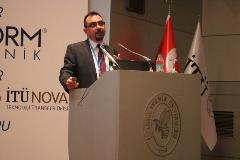Project Title: Safety and Health , Sustainability and Facility Management with Design In Restoration and Renovation Projects of Industrial Heritage Buildings with Building Information Model
Project Type: TUBİTAK Project
Project Coordinator: Doç.Dr. Gürkan Emre Gürcanlı
The concept of industrial heritage has emerged with the international recognition of the goals of preserving old industrial structures, and these structures, which have significant value in the country's economy and in the region when they are active in production, and all kinds of facilities, equipment, additional housing and social facilities associated with them are evaluated within this scope. With the growth and transformation of cities, it is important how the abandoned industrial buildings will be added to the city.Several recent studies have concluded that the conversion of these old buildings is beneficial in economic and historical terms. Industrial heritage transformation projects have unique characteristics and risks, and the restoration and/or re-functioning processes of these buildings differ from other construction projects. The use of building information modeling is a necessary and almost mandatory technology, as these phenomena require the participation of different parties. However, the number of studies in which building information modeling is applied to industrial building transformation projects is few, and there are no studies covering all areas of health and safety through sustainability, facility management and design in these projects. Building Information Modeling (BIM), which brings a new perspective to design, construction and operation processes, is an integral part of construction project management, because it provides solutions to many problems in the construction industry and provides modeling of these problems before construction. It reduces possible errors, changes during construction and conflicts arising from it, as well as providing a structure open to the participation of interested parties by including business, sustainability and health / safety issues in the design processes. Based on this shortcoming, the experiences and projects in Germany, which is one of the most important countries in terms of the transformation of industrial heritage, will be examined. Studies will be carried out in the Department of Civil Systems Engineering under the Civil Engineering Institute under the chairmanship of Prof. Dr. Timo Hartmann, an international consultant from Berlin Technical University, one of the leading technical universities in Germany. The outputs of the renovation projects carried out in Europe, where Hartmann is involved as a researcher and project coordinator, will be examined, and the industrial heritage building inventory of Berlin and Ruhr region, their classification, information and documents will be collected. The most general work items, construction methods and building elements in the examined structures will be determined, the work items, construction methods and health and safety hazards of the materials will be determined as they are made, and the hazards in the use, maintenance and repair (operation) phase will be evaluated. For this, a survey will be made, and then a library of safe construction method information specific to industrial buildings will be created by preparing object model definition levels, Context and Nature of Risks Tables and Construction Operations Building Information Exchange tables. It is also aimed to transform the project into a product in cooperation with a software company for the production of add-ons to the existing BIM software. It is thought that it will contribute to the evaluation of industrial heritage projects under the coordination of the Ministry of Environment and Urbanization and with the contribution of the relevant municipalities.
